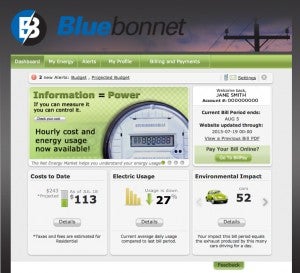This commentary originally appeared on EDF’s Texas Clean Air Matters blog.
Everywhere you turn these days, you hear someone mention the emergence of big data and how our lives will be more and more reliant on numbers. Well the world of electric cooperatives (co-ops) is no exception. Originally emerging out of the establishment of the Rural Electrification Administration, co-ops enabled rural farmers and ranchers to create customer-owned electric utilities in areas that are not serviced by traditional utilities.
I recently visited the Bluebonnet Electric Cooperative (Bluebonnet), one of the Texas’ largest co-ops providing energy to 14 counties, spanning the outskirts of Austin to Houston and boasting an impressive 11,000 miles of electric lines, 83,000 electric meters and 63,000 members. Who would have thought so much big data is coming out of rural Texas?
What makes this co-op particularly unique is its smart grid, which is attracting some serious attention.
Unlike other traditional utilities, Bluebonnet does not generate any of its own electricity. Instead, it buys electricity from the Lower Colorado River Authority and CPS Energy, both pioneers for clean, renewable energy. Because of this, Bluebonnet is able to concentrate its energy (pun intended) on using new technologies to provide reliable power and enhance customer satisfaction.
Bluebonnet’s CEO Mark Rose and his staff recently gave me a tour of the co-op’s online dashboard, which provides Bluebonnet members with detailed information on their electricity use. The amount of information readily available to customers is impressive, and the dashboard acts as a great tool to boil down much of this big data into digestible, understandable formats. Bluebonnet members view the information on their own personal energy dashboards in three categories: cost, usage and environmental impact:
Cost
The cost tab displays your current monthly electricity bill, as well as a projected monthly bill for the following month based on previous usage. If you want to dive deeper (like I would), a different chart can show you your energy usage each day. On top of that, you can view hourly data to see what time of day you use the most energy.
All of this information empowers Bluebonnet members to control how they use energy and reduce electricity costs. Presently, the dashboard shows data with an eight hour delay, but Bluebonnet’s goal is to show energy data the exact moment it’s used (real-time), so that members can gain control and make savvy energy choices.
Usage
While the cost tab shows electricity in dollars and cents, the usage tab shows energy in terms of units (i.e. kilowatt-hours or kWh). This tab compares the current month’s energy consumption to the previous months, highlighting if you’ve increased or decreased your electricity use. Just like the cost tab, you have the option to view daily or hourly usage, but this time in kWh rather than dollars. Additionally, on its website Bluebonnet offers some effective tips for members looking to conserve energy. The site even shows a breakdown of how much energy appliances use nationally. For instance, heating and cooling use about 56% and refrigerators use about 5%.
Impact
Bluebonnet’s unique approach shows members the environmental impact of their energy decisions in the form of understandable, real-world comparisons such as pounds of trash produced, number of trees needed to offset pollution or exhaust produced from certain number of cars driving per day. These types of comparisons make our energy carbon footprints feel ‘real’ and, hopefully, manageable.
In addition to its dashboard, Bluebonnet has a mobile app that enables members to check their electricity usage from anywhere. Members can also sign up for email or text message alerts to notify them when their bill reaches a certain dollar amount, which makes saving money even easier.
One challenge the utility faces is insufficient internet access in many of the rural communities it serves. Poor internet access makes two-way communication between Bluebonnet and its members difficult, but the co-op understands this communication gap and is figuring out how to bridge this. Regardless, the co-op should be commended for making a serious commitment to becoming a leader in clean energy and providing health, environmental and economic benefits to its members.
In the future, Bluebonnet hopes to give its members even greater opportunities to manage the energy use and further reduce their electric bills. As the old saying goes, “knowledge is power”, especially when it comes to reducing our energy use and its environment impact.










